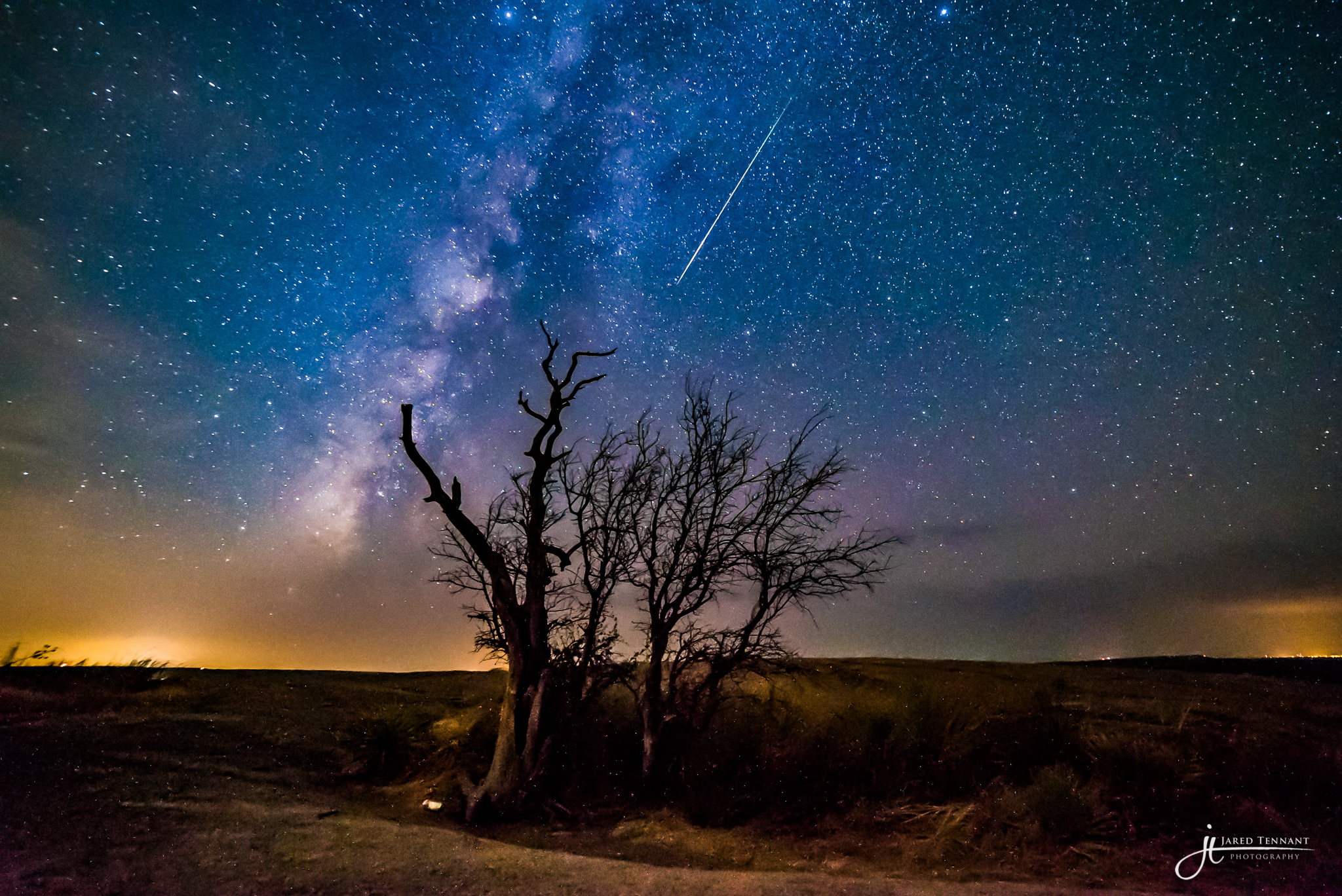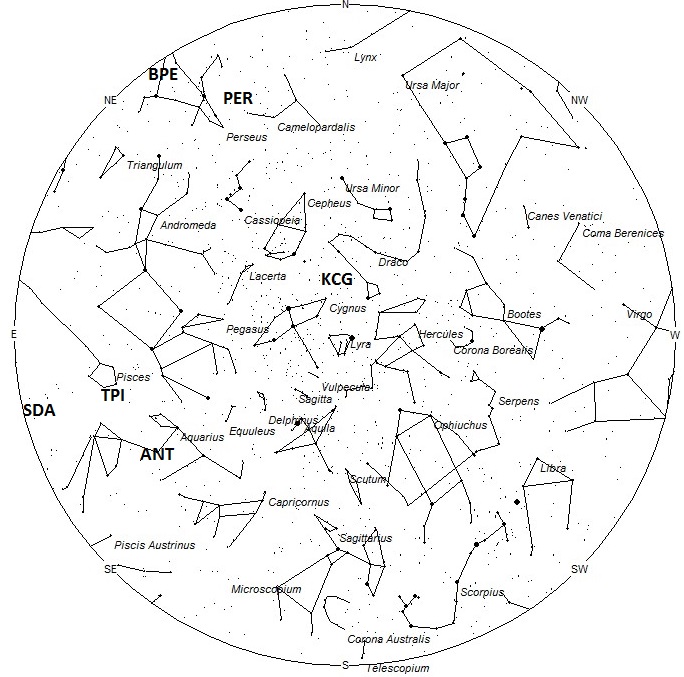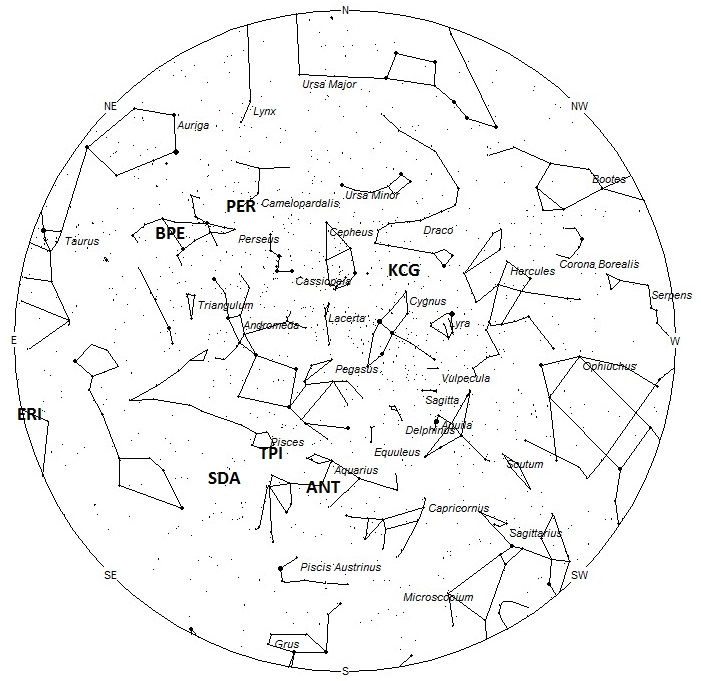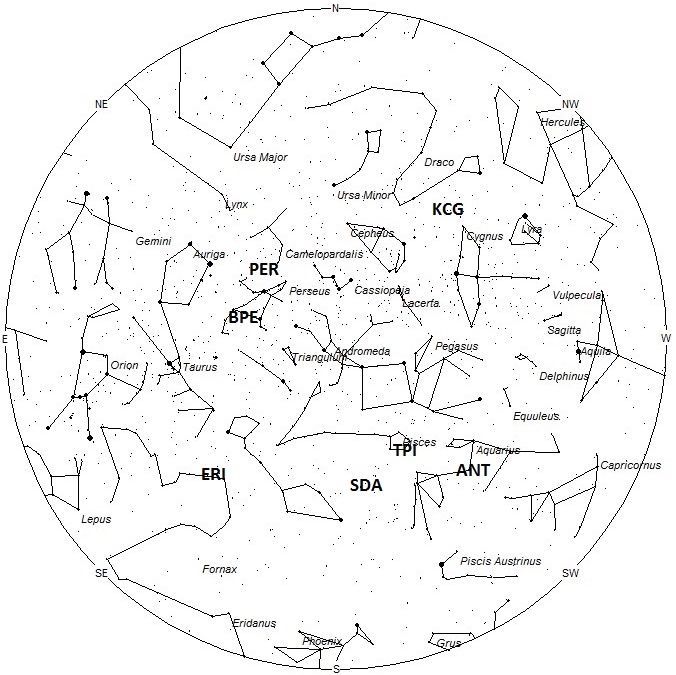
Perseid Meteor, Agust 12th 2015 – Central Texas, USA © Jared Tennant
During this period the moon enters the evening sky as a slender crescent and waxes to nearly one-half illuminated. It will be limited to the evening sky so the more active morning hours will be unaffected by moonlight. The estimated total hourly meteor rates for evening observers this week is near 5 as seen from mid-northern latitudes (45N) and 4 as seen from tropical southern locations (25S). For morning observers the estimated total hourly rates should be near 30 as seen from mid-northern latitudes (45N) and 20 as seen from tropical southern locations (25S). The actual rates will also depend on factors such as personal light and motion perception, local weather conditions, alertness and experience in watching meteor activity. Note that the hourly rates listed below are estimates as viewed from dark sky sites away from urban light sources. Observers viewing from urban areas will see less activity as only the brightest meteors will be visible from such locations.
The radiant (the area of the sky where meteors appear to shoot from) positions and rates listed below are exact for Saturday night/Sunday morning August 15/16 These positions do not change greatly day to day so the listed coordinates may be used during this entire period. Most star atlases (available at science stores and planetariums) will provide maps with grid lines of the celestial coordinates so that you may find out exactly where these positions are located in the sky. A planisphere or computer planetarium program is also useful in showing the sky at any time of night on any date of the year. Activity from each radiant is best seen when it is positioned highest in the sky, either due north or south along the meridian, depending on your latitude. It must be remembered that meteor activity is rarely seen at the radiant position. Rather they shoot outwards from the radiant so it is best to center your field of view so that the radiant lies at the edge and not the center. Viewing there will allow you to easily trace the path of each meteor back to the radiant (if it is a shower member) or in another direction if it is a sporadic. Meteor activity is not seen from radiants that are located below the horizon. The positions below are listed in a west to east manner in order of right ascension (celestial longitude). The positions listed first are located further west therefore are accessible earlier in the night while those listed further down the list rise later in the night.
These sources of meteoric activity are expected to be active this week.
The Kappa Cygnids (KCG) peak on the evening of August 17th (Aug 18 UT) from a radiant located at 18:30 (277) +58. This area of the sky is actually located in southern Draco, 8 degrees northeast of the 2nd magnitude star known as Eltanin (Gamma Draconis). These meteors are best seen as soon as it becomes dark in the evening hours. Rates are expected to be near 1 per hour as seen from the northern hemisphere. These meteors are not well seen from the southern hemisphere due to a low radiant altitude. With an entry velocity of 23 km/sec., the average Kappa Cygnid meteor would be of slow velocity.
The center of the large Anthelion (ANT) radiant is currently located at 22:24 (336) -08. This position lies in central Aquarius near the faint star known as Theta Aquarii. These meteors may be seen all night long but the radiant is best placed near 0200 local daylight saving time (LDT) when it lies on the meridian and is positioned highest in the sky. Due to the large radiant area, meteors from this source may also appear to radiate from Capricornus and western Pisces, as well as Aquarius. Rates at this time should be near 3 per hour no matter your location. With an entry velocity of 30 km/sec., the average Anthelion meteor would be of slow velocity.
The Theta Piscids (TPI) are active from August 8 through September 1, with the peak falling on August 20th. These meteors have a radiant currently located at 23:16 (349) +03. This area of the sky is located in western Pisces, just south of the faint star known as Gamma Piscium. The radiant is best placed near 0300 LDT, when it lies highest in the sky. Rates are expected to be near 1 per hour no matter your location. With an entry velocity of 39 km/sec., most activity from this radiant would be of average velocities.
The last of the Delta Aquariids (SDA) will be seen during this period. The radiant is currently located at 00:12 (003) -09. This position is located in western Cetus, 2 degrees west of the faint star known as Iota Ceti. Hourly rates will be less than 1 per hour no matter your location. The radiant is best placed near 0300 LDT, when it lies highest in the sky. With an entry velocity of 42 km/sec., most activity from this radiant would be of average velocities.
The Perseids (PER) are now past maximum activity and rates are dwindling with each passing night. This weekend the radiant will be located at 03:36 (054) +59. This area of the sky actually lies among the stars of Camelopardalis, 10 degrees north of the 2nd magnitude star known as Mirfak (Alpha Persei). This area of the sky is best seen during the last hour before dawn when the radiant lies highest above the horizon in a dark sky. Rates this weekend (at 4am local daylight saving time) are expected to be near 10 per hour as seen from the northern hemisphere and 2 per hour as seen from south of the equator. Rates seen earlier in the night will be less. With an entry velocity of 61 km/sec., the average Perseid meteor would be of swift speed.
The last of the Eta Eridanids (ERI) will be seen this weekend from a radiant located at 03:16 (049) -08. This area of the sky is located in western Eridanus 4 degrees east of the 4th magnitude star known as Azha (Eta Eridani). This area of the sky is best seen during the last hour before dawn when the radiant lies highest above the horizon in a dark sky. Rates are expected to be less than 1 per hour no matter your location. With an entry velocity of 66km/sec., most activity from this radiant would be of fast velocities. I managed to see a few of these meteors during the Perseid maximum. They were impressive with their high velocity and long trails. The brightest members also exhibited an orange color.
The last of the Beta Perseids (BPE) will be seen during this period. The radiant is currently located at 03:36 (054) +36. This position lies in southern Perseus directly between the bright stars known as Algol (Beta Persei) and Zeta Persei. Current rates are expected to be less than 1 per hour no matter your location. The radiant is best placed during the last hour before the start of morning twilight when it lies highest in a dark sky. With an entry velocity of 68 km/sec., most activity from this radiant would be swift. This source was previously listed as the Alpha Triangulids (ATR)
As seen from the mid-northern hemisphere (45N) one would expect to see approximately 12 sporadic meteors per hour during the last hour before dawn as seen from rural observing sites. Evening rates would be near 4 per hour. As seen from the tropical southern latitudes (25S), morning rates would be near 9 per hour as seen from rural observing sites and 3 per hour during the evening hours. Locations between these two extremes would see activity between the listed figures.
The table below presents a list of radiants that are expected to be active this week. Rates and positions are exact for Saturday night/Sunday morning except where noted in the shower descriptions.
| SHOWER | DATE OF MAXIMUM ACTIVITY | CELESTIAL POSITION | ENTRY VELOCITY | CULMINATION | HOURLY RATE | CLASS |
| RA (RA in Deg.) DEC | Km/Sec | Local Daylight Saving Time | North-South | |||
| Kappa Cygnids (KCG) | Aug 18 | 18:30 (277) +58 | 23 | 23:00 | 1 – <1 | II |
| Anthelions (ANT) | – | 22:24 (336) -08 | 29 | 02:00 | 3 – 3 | II |
| Theta Piscids (TPI) | Aug 20 | 23:16 (349) +03 | 39 | 03:00 | 1 – 1 | IV |
| Delta Aquariids (SDA) | Jul 29 | 00:12 (003) -09 | 42 | 03:00 | <1 – <1 | I |
| Perseids (PER) | Aug 13 | 03:36 (054) +59 | 61 | 06:00 | 10 – 2 | I |
| Eta Eridanids (ERI) | Aug 20 | 03:16 (049) -08 | 66 | 06:00 | <1 – <1 | IV |
| Beta Perseids (BPE) | Aug 07 | 03:36 (054) +36 | 61 | 06:00 | <1 – <1 | IV |
 American Meteor Society
American Meteor Society


